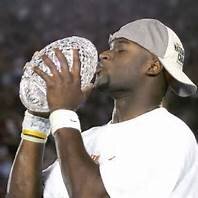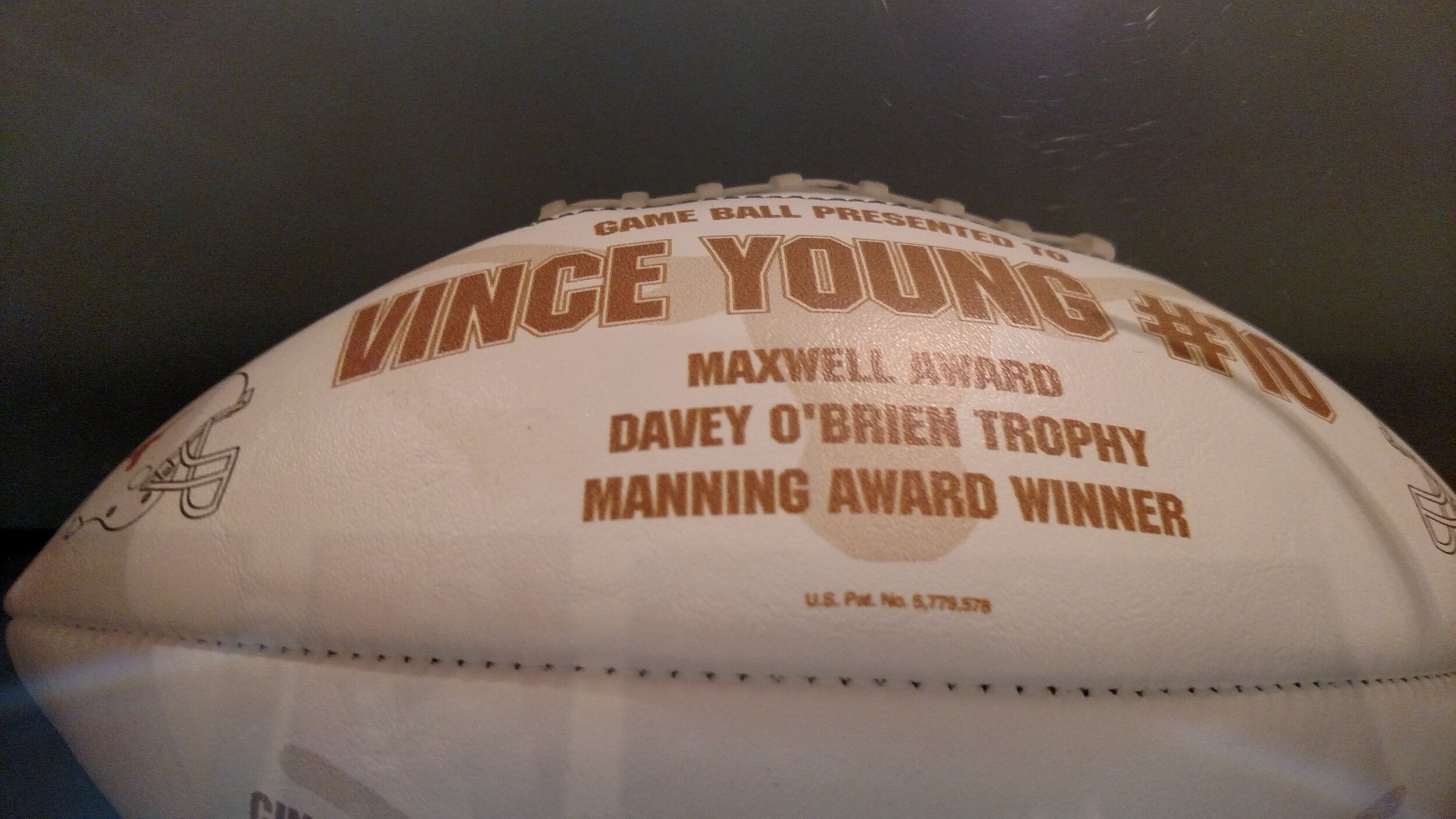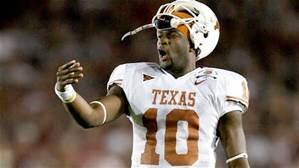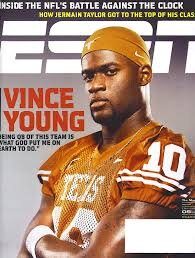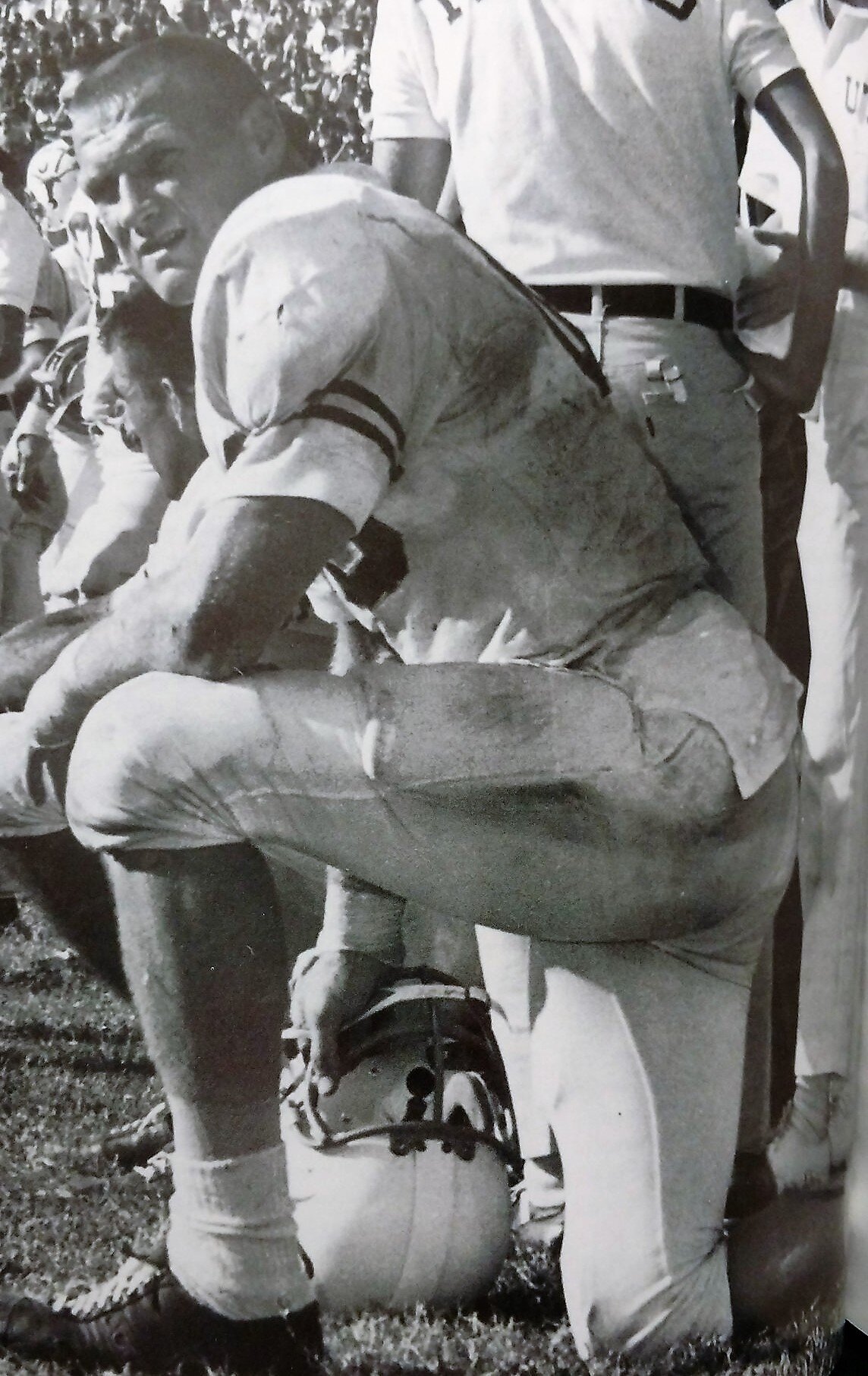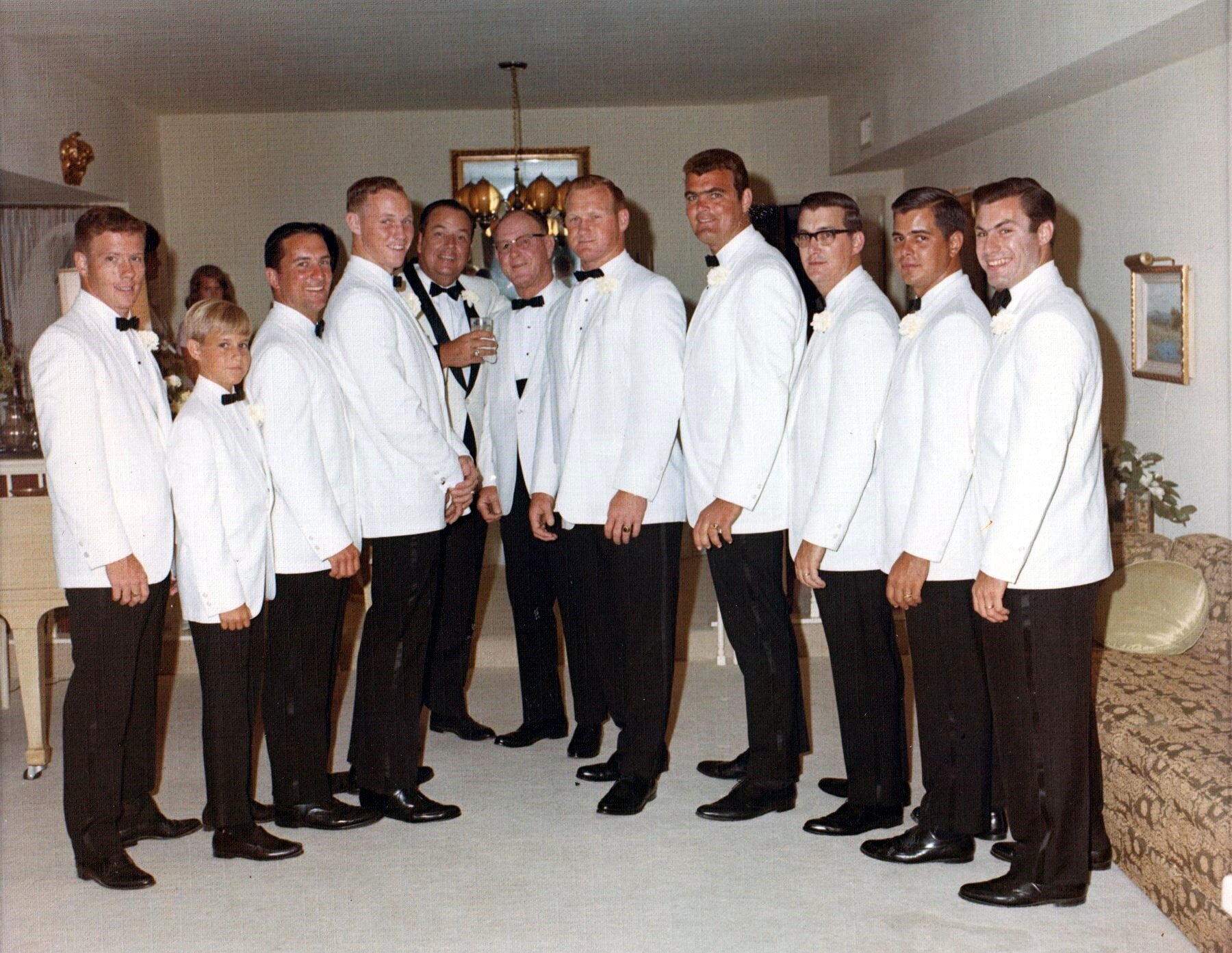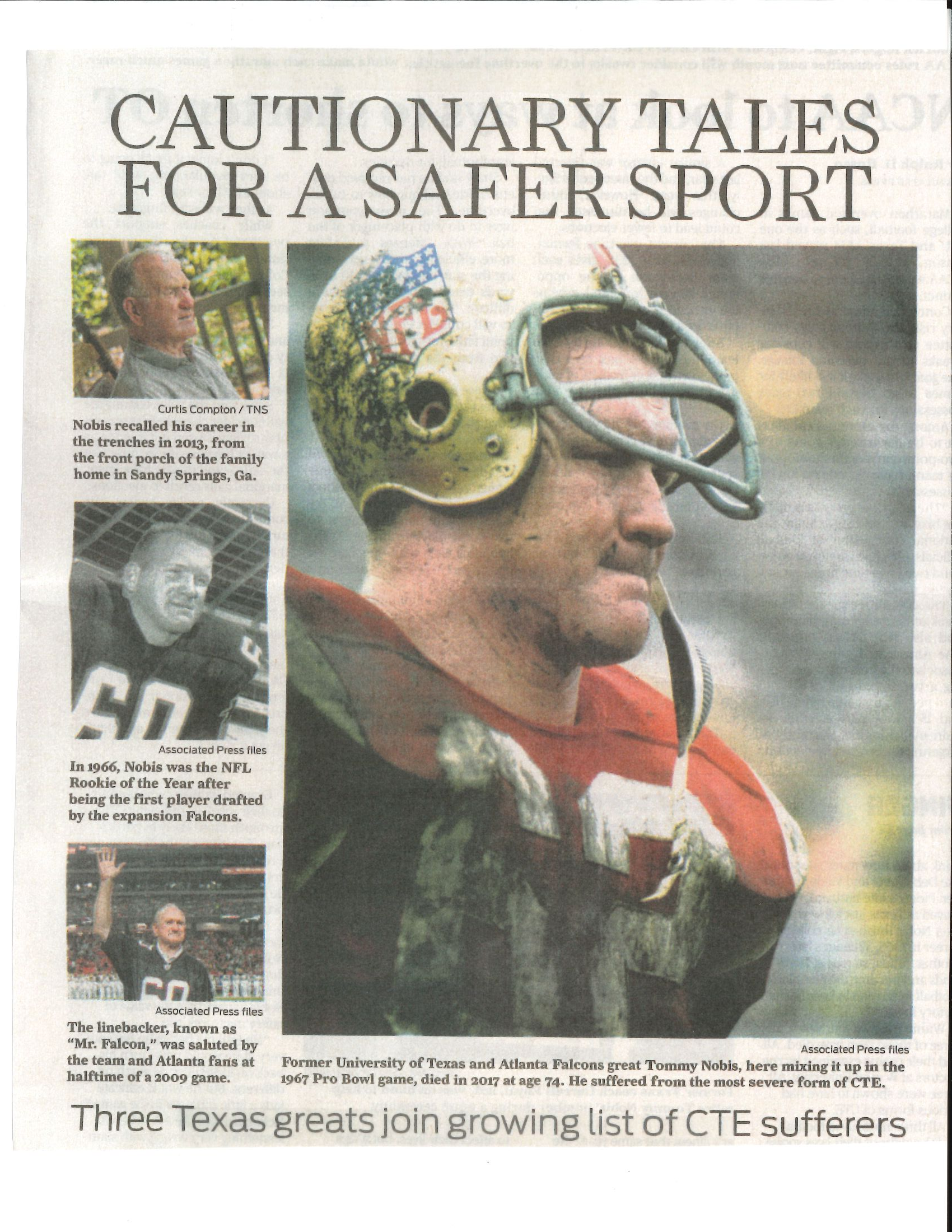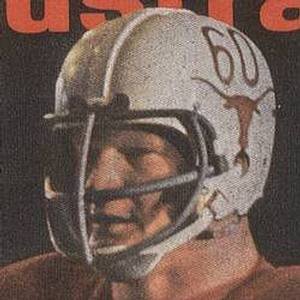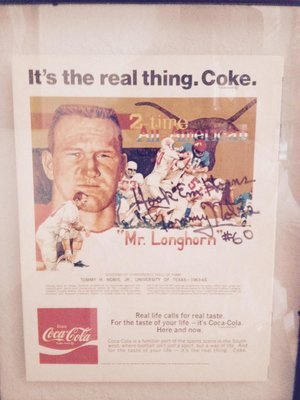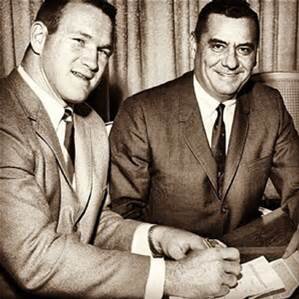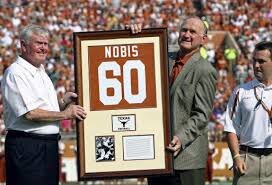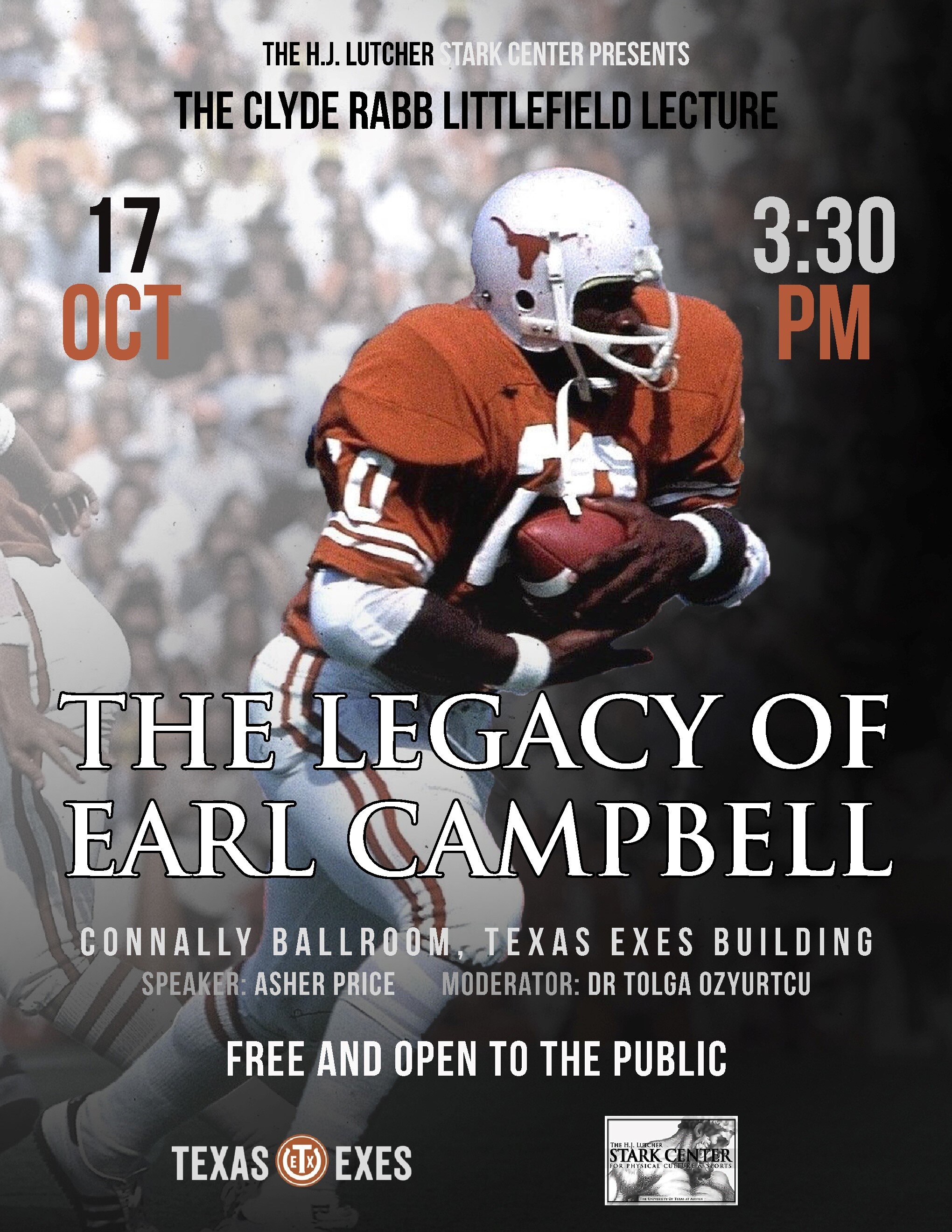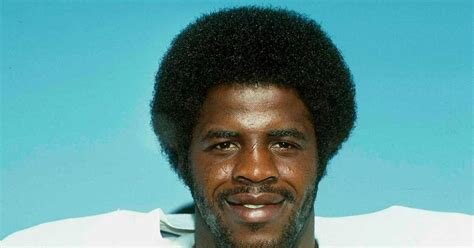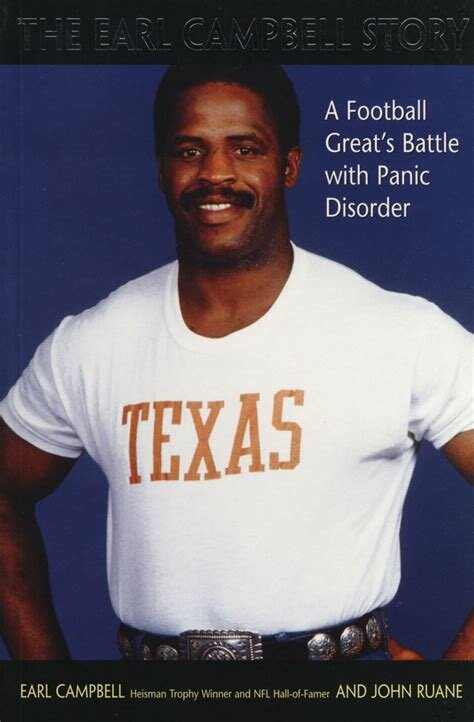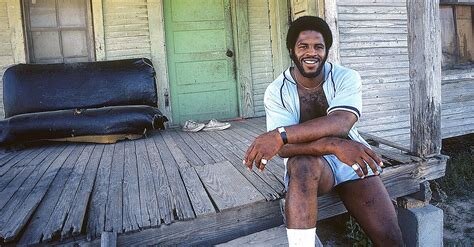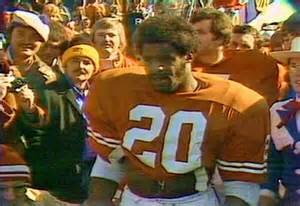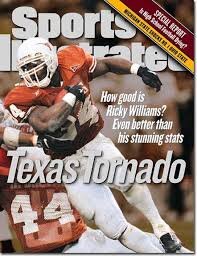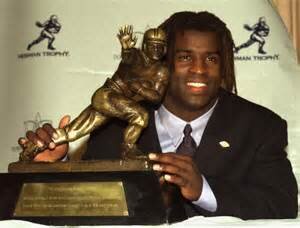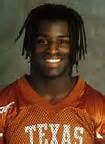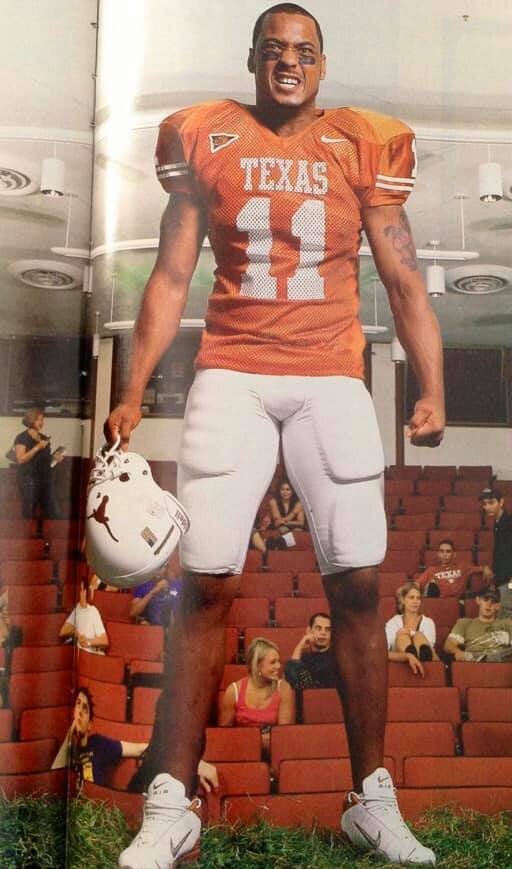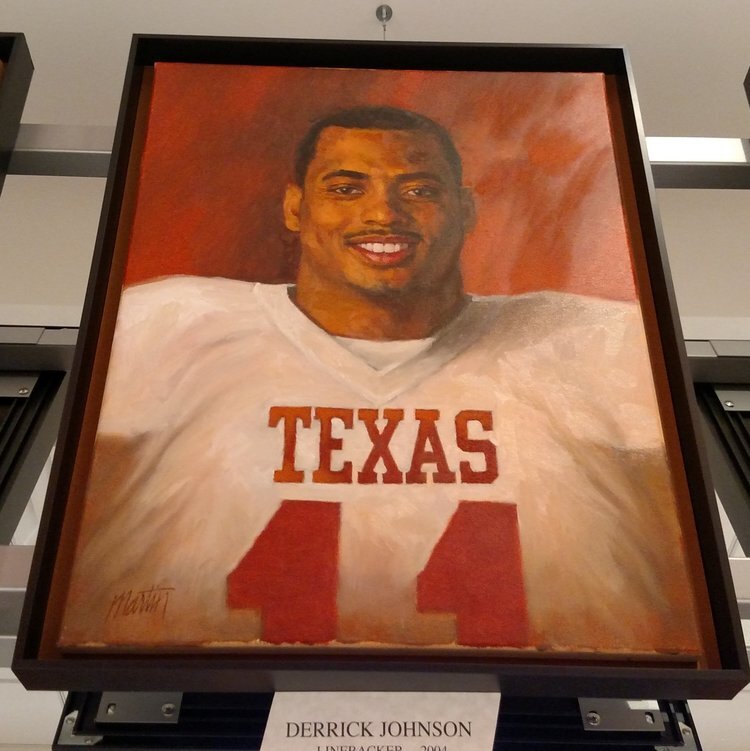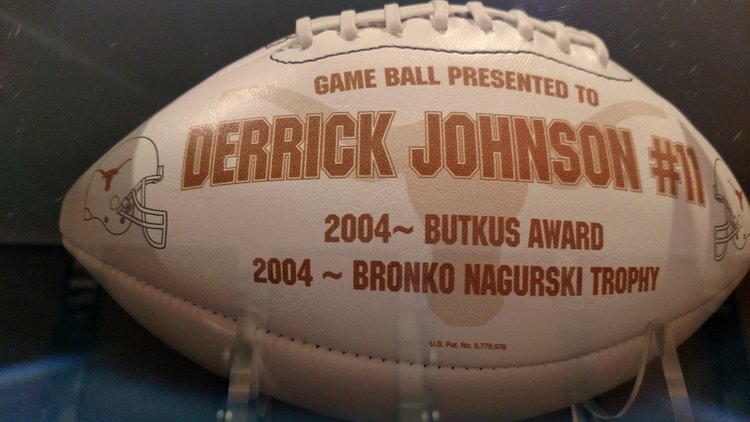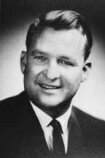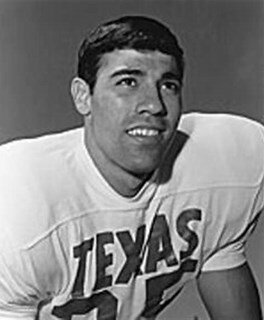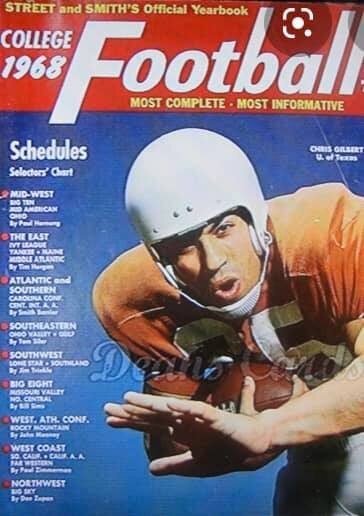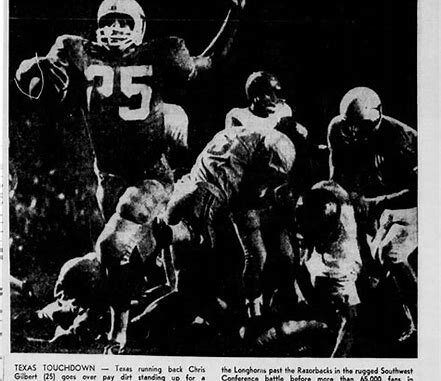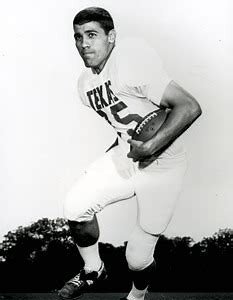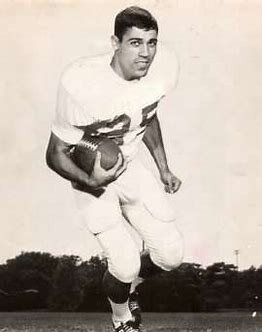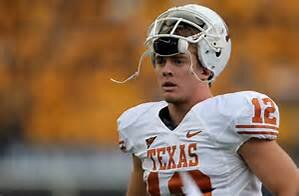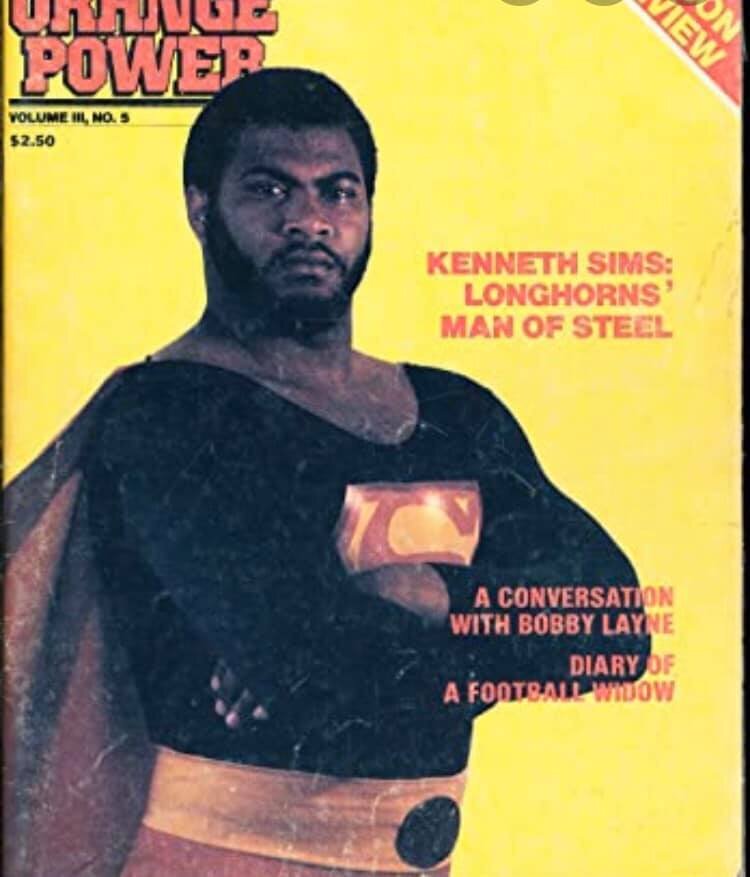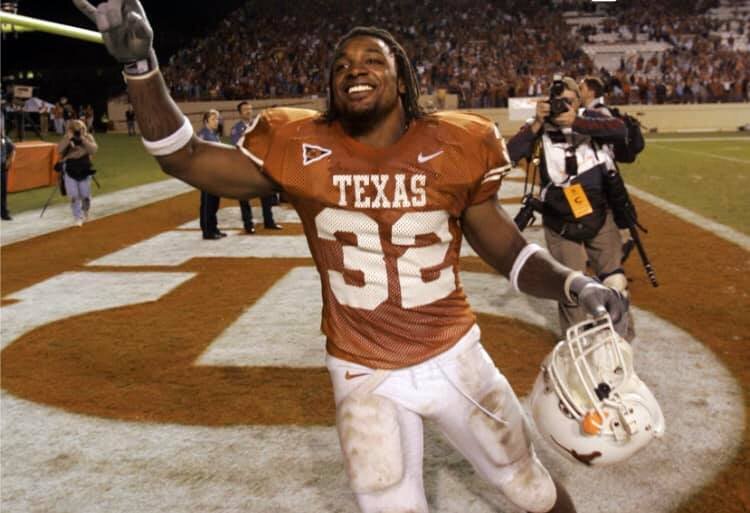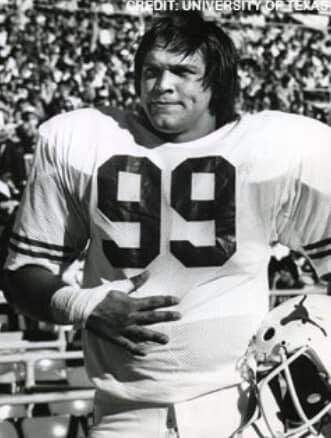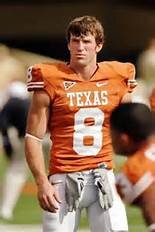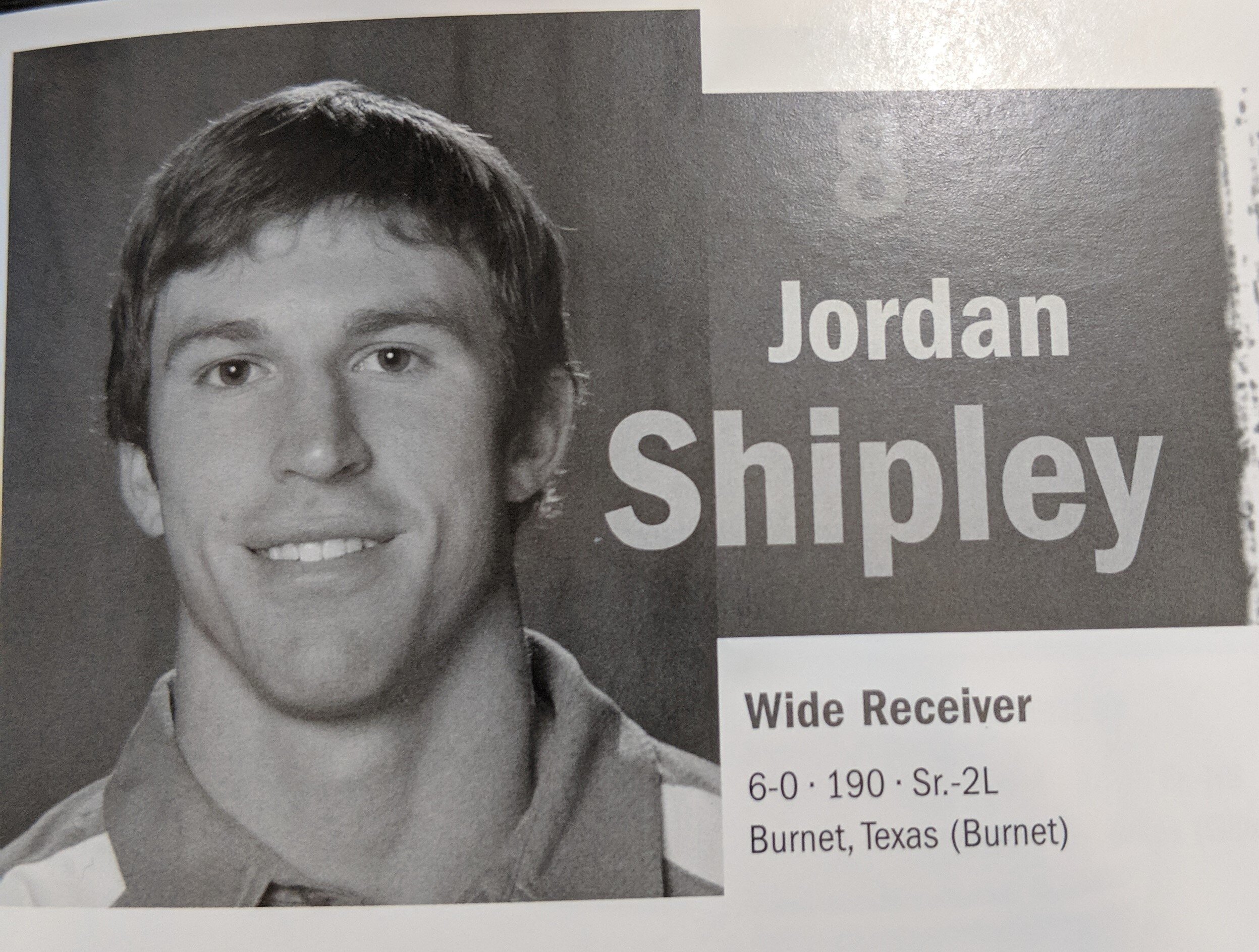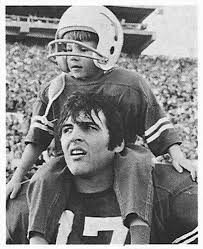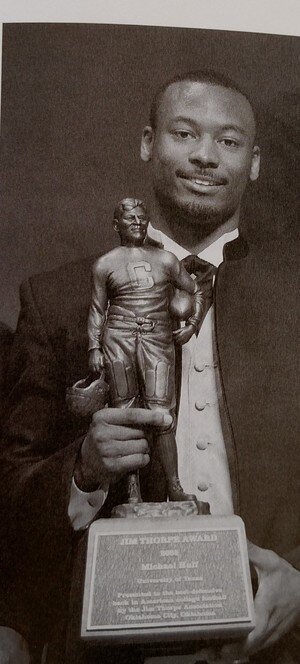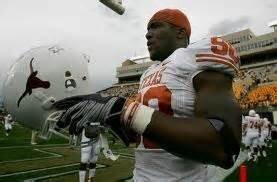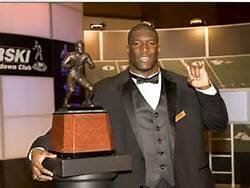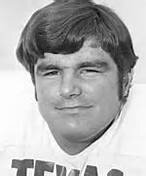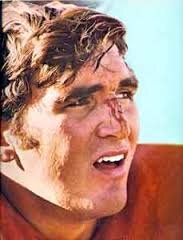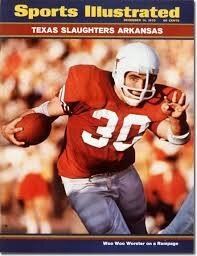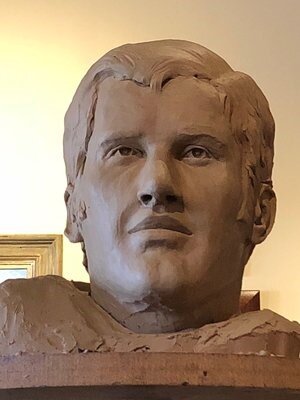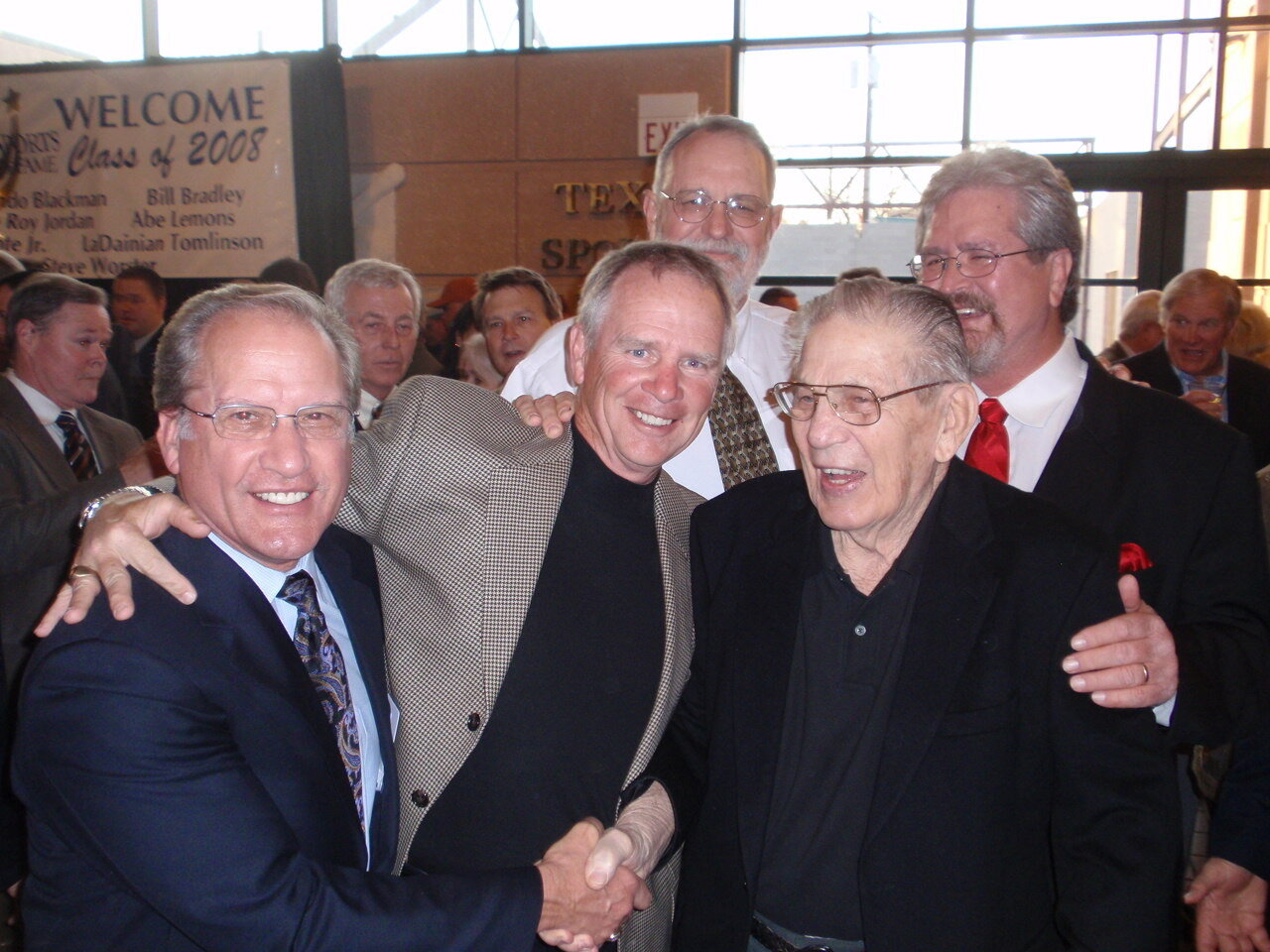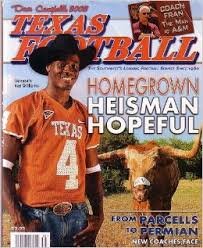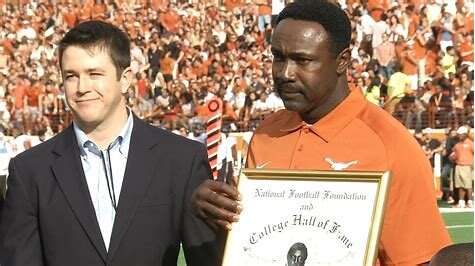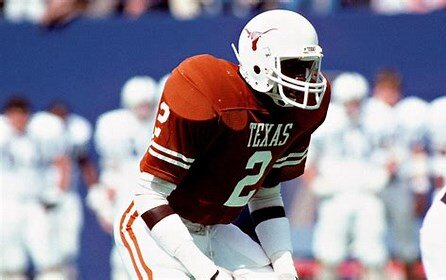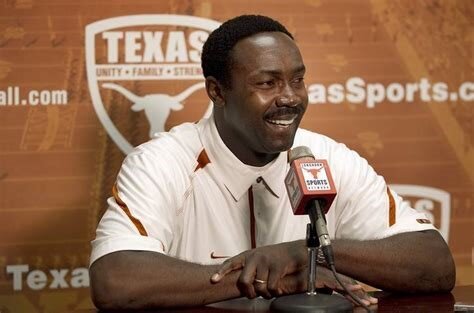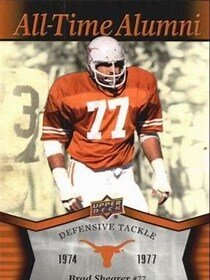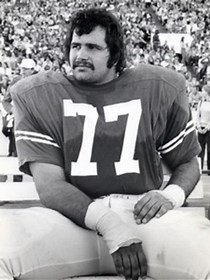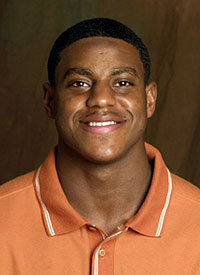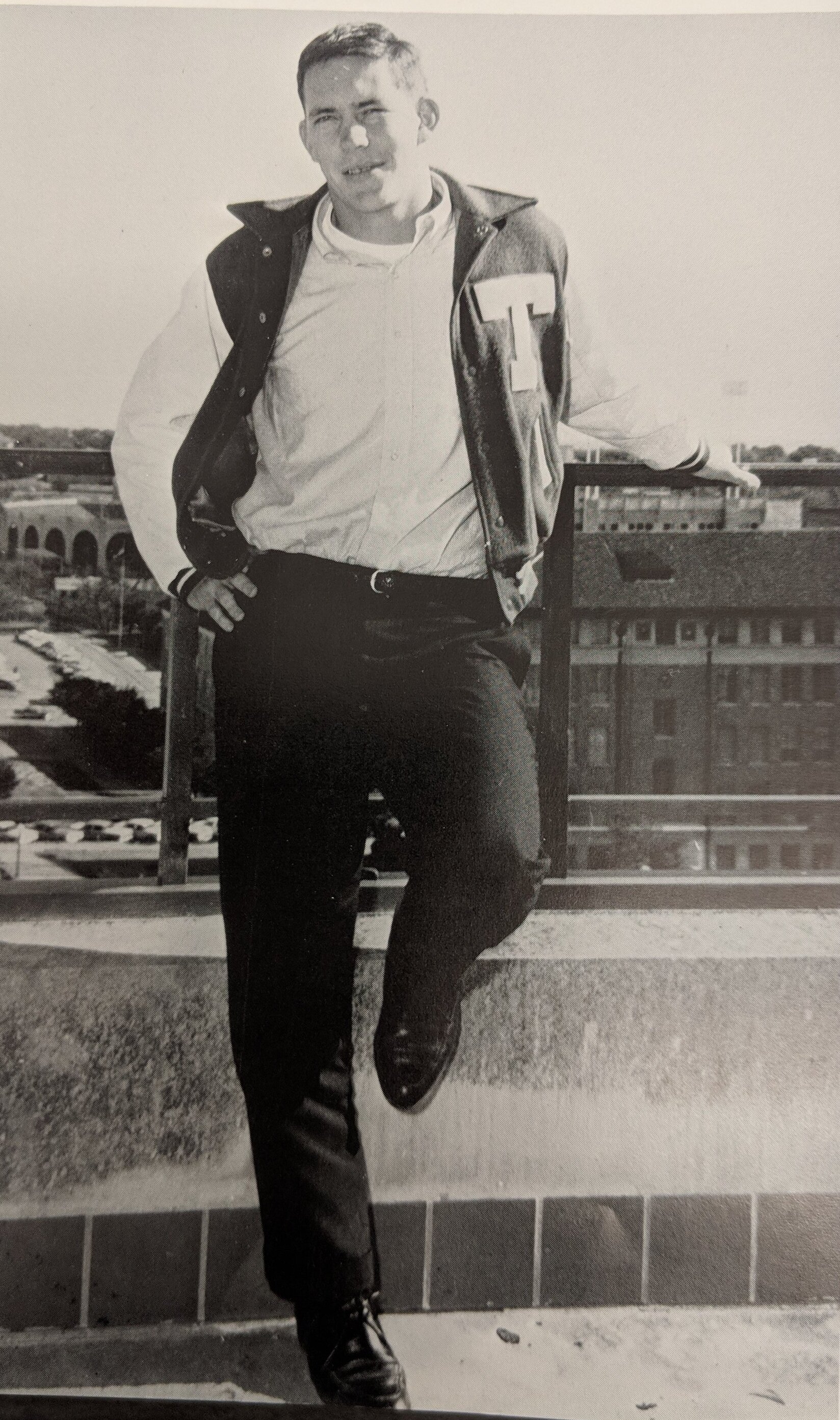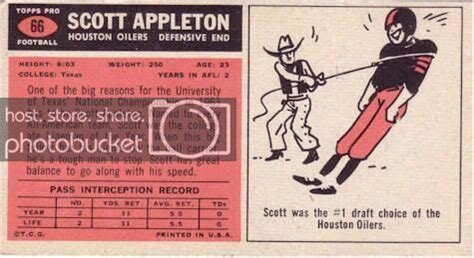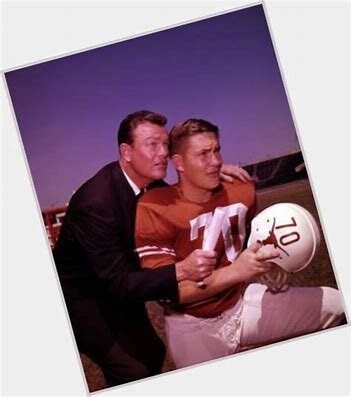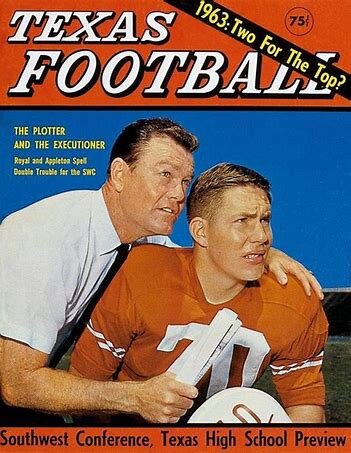IT’S MY OPINION- Anthony Snodgrass
Here, in my opinion are the top 25 Texas Longhorns ( any position ) of all time. It's been a tough few years, but Texas football has no shortage of candidates for the top-25 players of its long history.
The Longhorns have come a long way since their first team played four games in 1893. They've won four national championships with 32 conference titles and had two players hoist the Heisman Trophy.
The road to those accomplishments was paved by a long line of great football players, starting with Bobby Layne in the 1940s, then extending to Vince Young and Colt McCoy in the 2000s.
Some of them won national awards and shattered school records; others displayed amazing consistency in helping their teams achieve greatness as a whole. But they all made their mark on the history of the program and set the standard for every future player who wants to enjoy similar success.
Anthony Snodgrass says I'm going to go ahead and list the top 3 players on this topic as 1A, 1B, and 1C.... with these legends, there is no # 2 or 3. They were all as good as it gets, and all three are the best to play their respected positions at the University of Texas.
The Legacy of #10
One of the Three Greatest Longhorns of All Time.
Vince Young, Texas (2003-05)
Career Completions-Attempts-Interceptions: 444-718-28
Career Passing Yards: 6,040
Career Passing TDs: 44
Total Career Yards: 9,215
Total Career TDs: 81
Record as a Starter: 30-2
Accolades: 2005 Big 12 Offensive Player of the Year, 2005 consensus All-American, 2005 Davey O'Brien Award winner, 2005 Manning Award winner, 2005 Maxwell Award winner, 2006 BCS National Championship Rose Bowl Most Valuable Player.
Say what you will – everyone has to admit it – but as far as Texas Longhorns go, there are probably very few in the history of the program that can compare to Vince Young's sheer dominance when he was in Austin.
He may not have the laundry list of awards that some Longhorns on my list do, but if you saw Young play in his prime, there was no doubting his abilities. Even as a redshirt freshman backup, he put up great numbers including 1,155 yards through the air and another 998 on the ground. But in his two years as a starter in Austin, Young was virtually unstoppable.
As a sophomore, he led the Longhorns to an 11-1 record and the school's first-ever Rose Bowl appearance and win, for which he was named MVP.
Then came 2005. Young became the first player in NCAA history to pass for 3,000 yards and rush for another 1,000; only one other player has done it since. He led the Longhorns in a dominant undefeated season capped by a National Championship won in the Rose Bowl against a USC team that featured two Heisman winners.
If you are among the few who did not watch that game, don't worry, the Longhorn Network virtually plays it on repeat, as they should. Young put the team on his back and virtually won that game by himself. No one could find an answer for him all season. A lot of credit goes to Mack Brown's coaching staff for changing the offense so that it would cater specifically to Young's talents.
Young also played with one of the most talented rosters from top-to-bottom in college football history, but there was no question it was Vince Young's team.
It was nothing short of a crime that he did not win the Heisman that year; but the All-American was awarded the O'Brien, the Maxwell, the Manning and multiple Player of the Year honors. He is one of only four players in history to win the Rose Bowl MVP twice.
Raise your hand if you're surprised to see Vince Young near the top of the best all-time players in Texas history ... I would imagine very few hands are raised. That's because Young was an absolute difference maker when he stepped foot on the field. Young offered a threat as both a passer and runner, though his running skills are often most recognized, and understandably so. His career 6.8 yards per carry average tops the Texas record books, and his 3,127 career rushing yards ranks No. 4 in program history.
He may have been a "flash in the pan" in the NFL, as he slowly faded into obscurity after a jaw-dropping rookie season, but Young's place in college football is very much cemented. A 30-2 record, a National Championship and a highlight reel of a college career was enough to get his jersey number "10" retired in Austin. In the same way, his accomplishments were certainly enough to earn him one of the top spots on my list.
Simply put # 10 was amazing and was a treat to Longhorn fans everywhere when he stepped on the field in college.
Three way tie for #1 - the 3 Greatest players in Texas Longhorn football History
TOMMY NOBIS (1963-65)
National champion (1963)
Outland Trophy (1965)
Maxwell Award (1965)
Knute Rockne Memorial Trophy (1965)
Consensus All-American (1965)
Longhorns No. 60 retired
That right there should be all you need to know about Tommy Nobis.
He was a two-time All-American who played both linebacker on defense and guard on offense. He was Texas’ first No. 1 overall draft pick after being selected the team MVP in both 1964 and 1965. Nobis was the only sophomore (along with Phil Harris) who played on the 1963 national championship team. He emerged during a game against No. 1 Oklahoma as a sophomore, recording 18 tackles as the Longhorns won 28-7 to take over the No. 1 ranking in the country. Nobis just had the ability to uncoil like a rattlesnake and hit you with every ounce of his body. He finished his career with 136 tackles and eight interceptions, but the legend he left is probably bigger than any single statistic anybody will ever be able to put up.
Nobis is one of college football's all-time greatest linebackers. In his time with the Texas Longhorns he averaged nearly 20 tackles a game and, as the only sophomore starter, was an important participant on the Longhorns' 1963 national championship team, which defeated #2 Navy led by Heisman Trophy winner Roger Staubach in the Cotton Bowl.
As a junior in the 1965 Orange Bowl, he made one of the most famous tackles in the game's history. On fourth-and-inches, and clinging to a 21–17 lead, Nobis led his teammates to a game-saving halt of top-ranked Alabama’s QB Joe Namath for the win.
His senior year was one of the last years you saw guys playing both ways, but he still played lineman and linebacker. Everybody we spoke with told us that one of the things Nobis was interested in was continuing to play both ways. Still, most people don’t remember anything other than Texas when it comes to Nobis’ recruitment. Anthony King was a
member of the Longhorns, and, like Nobis, he went to Jefferson High School in San Antonio. King had a lot to do with Nobis coming to school in Austin.
Tommy was just awesome player In many people’s eyes he’s the greatest football player ever at the University of Texas. A lot of fans have the opinion that he was also slightly underrated. He was an all-American as an offensive guard and he was an all-American as a linebacker. He had the strength, He was in the pre-weight training era otherwise they would have had to license him. He had that explosion that seemed to be unleashed right at impact. In practice he was told he had to let the guys know before he was going to hit them because they didn’t want players getting injured. It had to be strangest thing ever to watch him tell them he was coming.
Just another legend at the University of Texas:
EARL CAMPBELL
Three way tie for #1 - the 3 Greatest players in Texas Longhorn football History
Seasons: 1974 to 1977
Career: 4,443 rushing yards, 765 attempts, 40 touchdowns, 5.8 yards per carry
Accolades: 1977 Heisman Trophy winner, 1977 consensus All-American, three-time consensus All-Southwest Conference selection, College Football Hall of Fame inductee, Pro Football Hall of Fame inductee.
His #20 retired.
While there's definitely an argument to be made that Tommy , Vince or Earl could claim the No. 1 spot. as the Greatest ever to play at the 40 Acres ...... It’s Earl’s time!!!
Campbell gets this spot on my list for achieving things nobody else had up until he arrived at Texas.
Earl Campbell is third on the all-time rushing yards list at Texas with 4,443 yards. His 1977 senior season was his best, rushing for 1,744 yards, which is the fifth-highest mark in school history. He also had 18 rushing touchdowns that season, which is the fifth-highest mark.
These numbers earned him the 1977 Heisman Trophy, making him the first to win this award and just the second Longhorn to win it to this day. Campbell is also just one of six Longhorns to have their numbers retired by the university.
The Sporting News and United Press International each named Campbell the college football player of the year. He was a unanimous All-American, being named to the first team by every major selector.
Campbell was the first Heisman Trophy winner in University of Texas football history after he led the nation in rushing and scoring in 1977, and was the first Longhorn to have his jersey number retired. His star-studded college career landed him in the College Football Hall of Fame. Campbell was the second Longhorn to be selected at No. 1 overall when the Houston Oilers picked him in the 1978 NFL Draft, and didn't disappoint as a professional. Campbell racked up nearly every NFL award possible during as a rookie, including Offensive Player of the Year, Most Valuable Player and Rookie of the Year!!
RICKY WILLIAMS
4th Greatest Player in Texas Longhorn History
Seasons: 1995 to 1998
Career: 6,279 rushing yards, 1,011 attempts, 72 touchdowns, 6.2 yards per carry
Accolades: 1998 Heisman Trophy winner, 1997 and 1998 Doak Walker Award winner, 1998 Maxwell Award winner, 1998 Walter Camp Player of the Year, 1998 Associated Press Player of the Year, 1997 and 1998 unanimous consensus All-American, 1997 and 1998 Big 12 Offensive Player of the Year, Texas Sports Hall of Fame.
Ricky Williams is without a doubt one of the best running backs to ever play college football, and could probably easily took the top spot instead of coming in at 4.
Williams racked up one of the highest honors in the game during his senior season playing under former head coach Mack Brown, and still holds several University of Texas school records, including the most career rushing yards and most career rushing touchdowns. His 100-yard performances in 28 career games is still ranked as the best in Texas football history.
Williams broke the NCAA career rushing record during the annual rivalry game held the day after Thanksgiving (this particular year fell on November 27, 1998) between Texas and Texas A&M. Needing only 11 yards to break Tony Dorsett's 22-year-old NCAA Division 1-A all-time rushing record (6,082), Williams approached the line of scrimmage with 1:13 left in the first quarter; taking the handoff, Williams spun through clearing blocks by left tackle Leonard Davis and left guard Roger Roesler. After surging past Texas A&M linebacker Warrick Holdman, Williams took advantage of a lead block by fullback Ricky Brown and then streaked down the left sideline. Williams then powered through a tackle attempt by Texas A&M safety Rich Coady at the A&M 12. He then took advantage of a block by wide receiver Wane McGarrity, barging past cornerback Jason Webster's tackle at the goal line.
Along with Earl Campbell, Williams has his own statue on the grounds of Darrell K. Royal – Texas Memorial Stadium, on the University of Texas campus in Austin, Texas. Both Campbell and Williams have statues at the stadium to honor their Heisman Trophy wins.
After his Heisman season, the New Orleans Saints selected Williams with the fifth overall pick in the 1999 NFL Draft.
5. DERRICK JOHNSON (2001-04)
The 5th Greatest player in Texas Longhorn History
You’re going to be on several top 5 list when you win the Bronko Nagurski Trophy as the nation’s top defensive player and the Butkus Award as the nation’s top linebacker no matter what the topic is.
There’s plenty to say about Derrick Johnson: He probably was the best linebacker Texas has had when it comes to defending the pass. But he was just as good going forward, too, as he holds the school record for career tackles for loss with 65. He finished his career with 458 tackles (No. 3 in UT history).
Offenses did all they could to stay away from him in 2004 as he was known for his ability to take the ball away. He finished with nine forced fumbles, a single-season Longhorn record. He was a two-time All-American and set the gold standard for modern linebackers at Texas.
A lot of people thought Johnson was headed to Oklahoma. He went to the Texas camp and ran back-to-back 4.4 40s. He committed to Texas within the week. He was considered one of the top-5 players in the state that year. After Corey Redding (who eventually moved to defensive end), he was the first real big-time linebacker that Texas had in recent years.
Johnson could run like a deer. He literally could run and close on the ball as well as any linebacker that has ever played at Texas. He got a little dinged up late in his career, and the shoulder gave him some problems, but he still played through it. One small play I remember was his freshman year in the Holiday Bowl against Washington. Texas is down but coming back and the Huskies had beaten Texas with the tight end over the middle all game long. Johnson made a diving tip of a pass late in the fourth, it was such a high effort play, that it was amazing to me and still the play I remember when thinking about him. It wasn't a highlight play per se, but it was a play where you saw he had that special desire to go with his athleticism and that play definitely affected the outcome of the game.
Johnson decorated the Longhorn record books with his outstanding performances over three seasons.
Some of his most notable records include the following:
All-time leader in interceptions for linebackers with nine.
Forced nine fumbles in 2004, an all-time record.
Forced 11 fumbles for his career, good for third on the all-time list.
All-time leader in career tackles for a loss with 65.
Third all-time in total tackles with 458.
In the NFL, Johnson has been a mainstay and consistent All-Pro on the defensive side of the ball for the Kansas City Chiefs.
Ask anyone to name one of the top players in Texas history, and you're sure to hear Derrick Johnson's name mentioned.
BOBBY LAYNE
6th Greatest Player in Texas Longhorn History
This one was a tough one for me guys. Layne could have been anywhere between 3 thru 6... and my toughest choice was between him and my # 5. This one was kinda long .. Enjoy
Seasons: 1944 to 1947
Career Completions-Attempts: 210-400
Career Passing Yards: 3,145
Career Passing TDs: 25
Record as a Starter: 28-6
Accolades: 1944 All-Southwest Conference, 1945 All-Southwest Conference, 1946 All-Southwest Conference, 1947 All-Southwest Conference, 1947 consensus All-American, 1st round NFL Draft pick, Pro Football Hall of Fame inductee, College Football Hall of Fame inductee.
Bobby Layne is often regarded as one of the greatest quarterbacks to ever play the game. Layne was named to four-straight All-Southwest Conference teams and his 28 career wins record ranks No. 3 in Texas football history.
Layne's college career led the Pittsburgh Steelers to select him with the third overall pick in the 1948 NFL Draft (though he was traded to the Chicago Bears before playing a snap of the 1948 season). Layne's professional career really took off when he was traded to the Detroit Lions, where he led the team to back-to-back NFL Championships in 1952 and 1953. Layne is one of six Longhorns to have their jersey retired inside Darrell K. Royal-Texas Memorial Stadium
Layne finished his Texas career with a school-record 3,145 passing yards on 210 completions and 400 attempts and 28 wins.
Bobby was one of the first inductees into the Cotton Bowl Hall of Fame and made the Cotton Bowl's All-Decade team (1937–1949) for the 1940s
Here are the records that Bobby owned at the time he finished his career at Texas.
NCAA & Cotton Bowl – Most Touchdowns Responsible For, bowl game (6), tied by Chuck Long in 1984, Dan LeFevour in 2007 and Paul Smith in 2008
NCAA & Cotton Bowl – Most Points Responsible For, bowl game (40)
NCAA – Highest completion rate (min. 10 attempts), bowl game (0.917), surpassed by Mike Bobo in 1998
NCAA – Most points scored, bowl game (28), surpassed by Barry Sanders in 1998
UT – Most Pass attempts, career (400), surpassed by Bret Stafford in 1986
UT – Most Pass completions, career (210), surpassed by Stafford in 1986
UT – Passing Yards, career (3,145), surpassed by Stafford in 1986
UT – Lowest percentage of passes intercepted (minimum 300 passes), career (7.8%), surpassed by Donnie Little in 1981
UT – Most starts, career (34), surpassed by Marty Akins in 1975
UT – Best winning percentage (minimum 1 season), career (80.5%), surpassed by T Jones in 1952
UT – Most quarterback victories, career (28), surpassed by Vince Young in 2005
UT – Most touchdowns, game (4), tied by Jim Bertelsen in 1969, Steve Worster in 1970, Earl Campbell in 1977 and A.J. "Jam" Jones in 1979; surpassed by Ricky Williams in 1997
UT – Most touchdown passes, career (25), surpassed by Peter Gardere in 1992
UT – Most points scored, game (28), broke his own record of 24 set earlier that year, surpassed by Williams in 1997
Cotton Bowl – Most consecutive completions, game (8), tied by Tony Graziani in 1996 and Clint Stoerner in 2000
Cotton Bowl – Highest completion rate (min. 10 attempts), game (0.917)
Cotton Bowl – Most points scored, game and career (28)
Cotton Bowl – Most touchdowns, game & career (4), tied by Tony Temple in 2008
Cotton Bowl – Most Points Responsible For, career (40)
Cotton Bowl – Most Touchdowns Responsible For, game & career (6)
Cotton Bowl – Most points rushing, game (18), surpassed by Temple in 2008
Cotton Bowl – Most touchdowns rushing, game (3), tied by Dicky Maegle in 1954 and Jim Brown in 1957, surpassed by Temple in 2008
Cotton Bowl – Most touchdowns rushing, game (3), tied by Maegle in 1954, Brown in 1957, and Jim Swink in 1957, surpassed by Temple in 2008
Cotton Bowl – Most yards per attempt (min 10 attempts), game (13.2), surpassed by James Street in 1969
7th Greatest Players in Texas Longhorns History
CHRIS GILBERT
Seasons: 1966 to 1968
Career: 3,231 rushing yards, 595 attempts, 28 touchdowns, 5.4 yards per carry
Accolades: Three-time All-Southwest Conference selection 66,67 and 68 and a 1968 consensus All-American.
Chris Gilbert made NCAA College Football history after the running back rushed for more than 1,000 yards in three-consecutive seasons. Gilbert also made his way into the Longhorns' record books as the first running back to reach the 2,000 and 3,000 rushing yard career mark.
Gilbert also has the honor of being the only player in UT history to be chosen “Most Valuable” 3 straight years by his teammates. Gilbert was also a 1968 Heisman finalist, and was elected to the College Football Hall of Fame in 1999.
Chris, In his career returned 20 kickoffs, averaging 22.7 yards on each and scored 28 touchdowns in 29 games.
COLT McCOY
8th Greatest Player in Texas Longhorns History
Seasons: 2006 to 2009
Career Completions-Attempts-Interceptions: 1,157-1,645-45
Career Passing Yards: 13,253
Career Passing TDs: 112
Total Career Yards: 14,824
Total Career TDs: 132
Record as a Starter: 45-8
Accolades: 2008 consensus All-American, 2008 Walter Camp Player of the Year, 2009 Big 12 Offensive Player of the Year, 2009 consensus All-American, 2009 Davey O'Brien Award winner, 2009 Johnny Unitas Golden Arm Award, 2009 Manning Award winner, 2009 Maxwell Award winner, 2009 Walter Camp Player of the Year
I'm going with Colt McCoy in my 8th spot because of how dominant of a player he was when he was on the field. (The fact I witnessed McCoy play every game of his career while in college probably plays a role, as well.) McCoy remains one of the best quarterbacks in college football history, and his name is found at the top of several record book categories. McCoy holds the record for most yards in a game, season and career for Texas, and it will take a hefty effort from a future QB to overtake his 45 win mark for the Longhorns. And remember, McCoy was a three-star recruit with very few D-I offers. To say McCoy exceeded expectations is a major understatement, and is a reason why he ranks as the second best quarterback to ever don a burnt orange jersey.
McCoy came up one win short of giving Texas its fifth national championship; he left the 2009-10 title game with a shoulder injury in the first quarter. Still, McCoy was a dominant force in burnt orange, compiling a school-record 13,253 yards — almost 5,000 more than No. 2 passer Major Applewhite. McCoy finished his Longhorn career with 45 wins, an NCAA record for victories by a starting quarterback.
KENNETH SIMS (1978-81)
9th Greatest Player in Texas Longhorns History
When Sims arrived at Texas, the Longhorn coaches tested him physically with the bench press. He tested in the 160-pound range.
By the time he left Texas, he was benching 425 and was a two-time All-American.
Sims spent his freshman year learning the basics of the tackle position. He spent his sophomore year behind Steve McMichael and Bill Acker, then became a force his junior year.
He won the Outland Award as a senior in 1981. He combined athleticism, with sheer strength, size and power. He was just so smooth and so quick for a big man. And he was so physically dominant that he ended up being the No. 1 pick overall in the NFL Draft and spent the next seven season with the New England Patriots.
Ken Dabbs stated one time he was at a hotel in Dallas getting ready to go to the airport and some Rice coaches came in. They asked him where he was was going, as he waited on a cab. One of the Rice coaches said he’d give Dabbs a ride. Once on the road he asked Ken what he thought of a guy from Kosse. The Rice coach said, I think he’s going to A&M.”
Kosse is a small town near Groesbeck. Dabbs and the Texas coaches had never heard of Sims or of Kosse, but they figured that out and went by the high school the very next day.
Akers said by the time Kenneth came along he had the combined strength, speed and quickness. I’ll never forget this. they had the Longhorn club meeting the week of the Oklahoma game.
Mike Parker spoke at that Thursday meeting in Dallas. All the people there were diehard Texas people. He said, ‘We’re going to win because of Kenneth Sims.’ His analogy all came down to just because Oklahoma has no match for him. Sure enough, he dominates the game.
CEDRIC BENSON
10th Greatest Player in Texas Longhorn History.
Seasons: 2001 to 2004
Career: 5,540 rushing yards, 1,112 attempts, 64 touchdowns, 5 yards per carry
Accolades: 2004 Doak Walker Award winner, consensus All-American (2004), No. 3 NCAA career touchdowns
Cedric Benson was one of the best running backs to make his way onto the 40 Acres. A four-year starter for Mack Brown, Benson has his name at the top of the Longhorns' record book with his school-record 1,112 carries.
The running back ranks second in Texas football history after he rushed for more than 100 yards in 25 career games, falling only behind Ricky Williams.
Cedric Benson spent his four years at the University of Texas being compared to Ricky Williams, but in my opinion Benson did enough on the field to stand out on his own.
His college career tremendously helped Benson's draft stock as the Chicago Bears selected him with the No. 4 overall pick in the first round of the 2005 NFL Draft. Benson played eight seasons in the National Football League, including seven with the Bears, before he retired following the 2012 football season.
STEVE McMICHAEL (1976-1979)
11th Greatest player in Texas Longhorns History.
Steve "Mongo" McMichael graduated from Texas as one of greatest defensive lineman to ever step on the 40 Acres.
A small-town prodigy, McMichael was a brawler at the defensive tackler position.
Full effort was always implied and he was totally unafraid to get caught at the bottom of the pile.
McMichael was a good athlete who played every sport in high school but nobody really wanted him in part because he came from the small school of Freer in south Texas. However, defensive coordinator Mike Campbell really liked him and that was enough. He played tight end his freshman year before moving to the defensive line.
McMichael was one of those guys that the tougher the situation, the tougher he got. Goal line fourth quarter, hot, sweaty, he was going to beat his guy.
To watch him play was an inspiration. His enthusiasm was contagious.
For his career, McMichael was a two-time All-American, once unanimous, and finalist for both the Lombardi Award and Outland Trophy after leading a blistering 1979 Longhorn defense.
Mongo graduated as the school's all-time leader in career sacks and tackles, and he is still in the top 10 for four other records.
He comes in at No. 7 on Texas’ career tackles list with an impressive 369. But that’s just the beginning of the story
David McWilliams said McMichael was just about the only guy he met who loved practice.
McMichael was one of those guys who always was disruptive. His best season might have been 1978, when he recorded 122 tackles and had 43 quarterback hurries, which is the third-most of any Longhorn in a single season. He had 28.5 sacks in his career, including 12 in 1977.
He went on to have a long and productive career with the Chicago Bears and later the Green Bay Packers.
Rick Ingraham
Steve McMichael followed Bill Acker from Freer HS to UT. I believe Glenn Blackwood nicknamed Steve BamBam from the Flintstones cartoon because he was just a wrecking ball type player. He was a tight end under Royal his Freshman year, but moved to defense under Akers. Good move! He was renamed Mongo by his Chicago Bears teamates. Good fit also, but his UT buds still call him Bam.
Link to a Bam Bam video is below
https://twitter.com/i/status/1244995517874163712
JORDAN SHIPLEY (2006-09)
12th Greatest player in Texas Longhorn History
When you think of the best players in the history of the Texas program, Jordan Shipley's name is sure to be mentioned.
What is even more impressive about him is the fact that his career was largely injury-prone, and he truly only played two seasons at full strength. Had he been healthy throughout his career, he would probably own every record in the books at Texas and be much higher on my list.
It’s hard to imagine a receiver putting together two better years than Shipley had during his final two on campus. In 2008 he caught 89 passes for 1,060 yards and 11 touchdowns. He did it with a combination of speed and precise route-running.
And then he one-upped himself the next season by catching 116 balls for 1,485 yards and 13 touchdowns. The Longhorns finished 25-2 during those two years. That doesn’t even begin to scratch the surface of how important he was to the Longhorns in 2008-09.
Jordan played with Stephen McGee in high school at class 3A Burnet for his dad Bob Shipley. It was one of the best combinations Texans had ever seen on the high school level. Jordan always had liked Texas, and I think he wanted to stay close to Burnet. He chose Texas over A&M and Texas Tech. Tech really tried hard and at one time, he almost took a visit out there, but decided against it and the rest is Longhorn receiving history.
Jordan Shipley was quite frankly the best Texas has ever had at wide receiver—He made the quality catches of Cotton Speyrer but also the tough catches over the middle. He was one of the most humble and grounded players to ever don the orange and white. The ultimate team-first player. His kickoff return against OU and his many touchdown punt returns made him one of the most valuable Longhorns ever as well. Big-time player. Big-time heart.
BILL ATESSIS (1968-1970)
13TH GREATEST PLAYER IN TEXAS LONGHORNS HISTORY
Bill Atessis was the best defensive player on one of the ten greatest teams in college football history. That pretty much sums it up.
Throw in career accolades such as two All-American selections and being named to the Austin American-Statesman's All-Time University of Texas team, and Atessis comes out as one of the most accomplished defensemen in Texas history.
Atessis was a member of teams which set a school record 30-game winning streak that currently stands as the twelfth-longest in NCAA history and was a three-year letterman and three-year starter at left defensive end.
Including two years as a starter on the back-to-back National Champion Texas Longhorns teams of 1969 and 1970. Was voted Longhorn Defensive MVP by the players and coaching staff both in 1969 and 1970.
The Longhorns also won three consecutive Southwest Conference championships and appeared in three consecutive Cotton Bowl Classic games, winning two during that time. Was a consensus 1st Team All-American in 1970 and was second team All-American in 1969. in 1970 he was voted Southwest Conference Co-Lineman of the Year (with Arkansas All-American Defensive end, Dick Bumpas). Consensus All-SWC choice in 1969 and 1970. Also was a finalist for Outland Trophy and finished fifth in the voting for the UPI Lineman of the Year, both in 1970.
Played in the Senior Bowl in Mobile, Alabama, in January 1971. Is a member, University of Texas Men's Athletics Hall of Honor, being voted in during 2001.
Texas Coach Darrell Royal called him a, "Super player, who never played a bad game in his three seasons with Texas .
Bill played in the Coaches' All-America Game in Lubbock, Texas, June 28, 1971. Singled out for his "tremendous game" by the NCAA as worthy of the player of the game award.
Played in what has been called "The Game of the Century" between #1 Texas and #2 Arkansas on December 6, 1969, with the Longhorns winning 15-14.
In 2005 was named to the All-Time University of Texas team by the University and was named to the Red River Rivalry All-time team by the Fort Worth Star-Telegram, also in 2005. In 2006, he was named number 16 on a list of the 50 Greatest players in Texas Longhorn history.
Bon Mallari
I didn't think there was a lineman in the country that could stop Bill Atessis one on one
14th Greatest Player in Texas Longhorn History
BRITT HAGER (1984-85, 87-88)
Britt Hager was the epitome of a guy who was all over the field and all over the opponent. You have to be if you’re going to lead a program like Texas in career tackles. But that’s exactly what Hager did, posting 499 in his career. He posted an amazing 195 tackles (120 solo) in 1988 to set single-season school records and earn All-American honors. Hager’s 195 tackles broke the Texas record for tackles in a season of 187, set in 1987 by..... well Britt Hager!!! You have to be smart , you have to be quick, you have to be athletic and most of all you must be determined to record 282 tackles in just two season... All the above describe Hager.
Texas recruiter David McWilliams went out and watched Britt at Odessa Permian in practice and they didn’t put him on the field a lot of the time because he was so disruptive to what the offense was trying to do.
He was another one of those guys who just wanted to come to Texas. His mother and father were just huge, huge Texas fans. As McWilliams said, “I’m not sure if there was anybody else who really competed with us.”
In my opinion want to know what the mold of an inside linebacker is supposed to look like? That was Britt Hager. But what was really different about him from other big-time players was his tenacity. He had a focus and an intensity that I don't think anybody could match.
Britt left Texas and went on to play nine seasons in the National Football League for the Philadelphia Eagles, Denver Broncos and St. Louis Rams.
Tim Reibe
I can attest, dude was a beast. Played against him my Jr year, San Angelo Central, was a top 5 showdown at SA stadium in front of 22, 000. They won, but we didn't lay down. If I remember correctly, Hager never missed a read at middle lb, played both sides the whole game, even had 16 stitches put in his hand and came back in. This was a Central team that had about 20 future scholoship players on it. Track season the dude went to state in discus, I believe.
Gary McIntosh
We all may disagree with some of the spots in the rankings. James Street was undefeated. But Hager commanded his position for 3 years at Texas and then did so in the pros for 9 more years. The all time leading tackler in a program with a lots of great defensive players. I think his ranking might even should have been closer to the front. But whether we agree or not with the specific slots, I'm glad Anthony is doing this. It creates great memories for us to talk about.. Hook 'em!!!
15th Greatest player in Texas Longhorn History.
Michael Huff (2002-2005)
There have been a bevy of great defensive backs come thru Austin thru the decades, namely All-Americans Nathan Vasher, Jerry Gray, Aaron Ross, Stanley Richard, Earl Thomas and Chris Carter. But none of them paired winning ways with outright talent like Michael Huff.
Huff was as much a self-made man as Texas has ever had. He came to school as a skinny track star and left as a physical, in-your-face player who didn't mind sticking his nose into any pending collision.
Huff was the total package at safety. He was blazing fast, had superb ball skills and was a sure tackler for two of the best Longhorn teams of the decade.
His career accolades include being the first Texas Longhorn to receive the Thorpe Award as the nation's top defensive back. He was also a consensus first-team All-American in 2005 and owns the school record for most interception returns for a touchdown (4) and highest interception return average (23.1).
Huff started an amazing 50 games for the Longhorns, recording 318 tackles, 44 pass breakups, six forced fumbles and seven interceptions.
During his Thorpe season in 2005, he recorded 109 tackles, including 10 behind the line of scrimmage, two sacks, an interception and 14 pass breakups.
If you had to sum up Huff's career in one game, it would be his performance against USC in the 2006 Rose Bowl. Understandably overshadowed by teammate Vince Young, Huff earned Defensive MVP honors with 12 tackles, one for a loss and a fumble recovery. He also led the crowd that stuffed LenDale White on 4th-and-2 to give Young the ball back one last time.
Huff was not been a slam dunk in the NFL, but his career at DBU stands above the rest.
16th Greatest Player in Texas Longhorn History .
BRIAN ORAKPO (2005-08)
Brian was as complete a defensive end as college football has ever seen, Orakpo was a force from the moment he stepped on the field. In fact, one could argue that the only blemish on his Longhorn career was the fact that he won only one national title
Orakpo used to wear tank tops to press conferences, and one look was all it took to realize why Orakpo could be so dominant on the field.
He was a physical specimen. And he backed up the look with his play, too. It’s surprising to see Orakpo only had 132 career tackles. But of those, 38 were behind the line of scrimmage. He had 11.5 sacks and four forced fumbles in 2008. His combination of quickness and strength was too much for opponents to handle. With Orakpo on one end and Sergio Kindle on the other, quarterbacks had no place to turn in 2008 when they faced the Longhorns. But that started with Orakpo. Offenses had to focus on him, and that ended up opening things up more for Kindle. Orakpo was going to make a play or two every game that season, it was just a matter of when it was going to happen.
As a senior he won virtually every award there was – the Lombardi, the Outland and the Nagurski.
Brian was not a household name when he committed. His high school teammate at Lamar, Andrew Kelson, actually was more heavily recruited. But Brian ran a 4.56 40-yard dash at a Nike camp, went to a couple summer camps and then the race was on. A&M had offered early, but when Mack Brown offered, it was over.
Orakpo just got better and better, the more he matured. He didn't have the quickness that Tony Brackens did, but had more overall strength and probably better technique
17th Greatest player in Texas Longhorn History
JERRY SISEMORE (1970-72)
Jerry with Coach Zapalac and Coach Bellard
Sisemore was so good that it’s hard to describe. Folks describe him as “a man among boys. He had good size but he was also quick. He was powerful yet athletic. He worked hard on the field and was devoted in the weight room. He wasn’t a real trash talker on the field, he let his play speak for itself.
Jerry helped lead the Longhorns to three straight SWC championships. He ended up as a unanimous two-time All-American and a first-round draft pick of the Philadelphia Eagles.
Sisemore didn’t even visit the campus , All he wanted to do was go to Texas. He didn’t need anything else. As soon as Coach Royal offered him a scholarship, Sisemore said, ‘That’s it, I’m coming!!!
Of all of the lineman at Texas he was just the best. He could run, he could block. He could do anything. He was an athlete. Honestly I think he could be higher then 17, but linemen do all the work and get little credit.
I don’t think in Longhorn history you could find a better tackle than Jerry .
As a sophomore, Sisemore was a regular on the 1970 Longhorn team that built an unbeaten streak to 31 games. The next year Sisemore blossomed into one of the nation's best linemen as he had the first of two consecutive seasons (1971 and 1972) where he was both an all-conference and Unanimous All-America selection.
In his 1972 senior year, Texas won its third consecutive Southwest Conference title and gained its third straight Cotton Bowl Classic bid. Sisemore was inducted to the College Football Hall of Fame in 2002.
18th Greatest player in Texas Longhorn History
Steve Worster —1968 to 1970
Career: 2,353 rushing yards, 457 attempts, 36 touchdowns, 5.1 yards per carry
Accolades: Two-time Consensus All-American (1969, 1970), three-time Consensus All-Southwest Conference selection, Texas Sports Writer's Association's Texas Athlete of the Year (1970), Texas High School Sports Hall of Fame
Steve Worster was one of the original members of Darrell Royal's Wishbone Offense while playing fullback for the Longhorns. During his time at Texas, Worster put up 10 career 100 yard performances while often splitting reps with teammates Chris Gilbert in 1968 and Jim Bertelsen in 1969 and 1970..
Worster was heavily recruited to play football for several schools. He chose to accept a scholarship to the University of Texas at Austin, where he played under coach Darrell Royal. He was the cornerstone of Royal's famed wishbone formation, which was introduced against the Houston Cougars in 1968. Texas Longhorn fans nicknamed Worster "Big Woo".
During his years at Texas, Worster rushed for 2,353 yards and scored 36 touchdowns. His teams won three Southwest Conference titles and two national championships. Worster was featured on the cover of Dave Campbell's Texas Football magazine in 1970 and finished fourth in the Heisman Trophy voting for the 1970 season. He was a two-time All-American (1969 and 1970) and three-time All-Southwest Conference selection, and was voted 1970 Texas Amateur Athlete of the Year by Texas Sports Writers Association. Worster has also been inducted into the Texas Longhorn Hall of Fame and the Cotton Bowl Hall of Fame. Though he was selected by the Los Angeles Rams in the fourth round of the 1971 NFL Draft he never played a down in the league
JAMES STREET/ QB - Seasons: 1967 to 1969
19th Greatest player in Texas Longhorn History
Career Completions-Attempts-Interceptions: 112-229-24
Career Passing Yards: 1,845
Career Passing TDs: 10
Total Career Yards: 2,660
He is not only the first of four quarterbacks who could legitimately stake claim to the top QB spot on this list, but he’s also the only undefeated quarterback in school history (20-0). He could run the option. He could pass. If asked, he probably could have played lineman. Street ran for 441 yards and passed for 699 for the 1969 national championship team. He was most known for his personality, which demanded everybody’s attention the minute he walked in the room. That’s part of what made him a great quarterback. He was hyper, loaded and ready to go at all time, and he was like that both on and off the field.
Total Career TDs: 20
Record as a Starter: 20-0
Accolades: 1969 All-Southwest Conference, Texas Sports Hall of Fame inductee, Cotton Bowl Hall of Fame inductee. Photo is James with Greg Ploetz
Street wasn’t very highly recruited out of high school because he was just 5-foot-9, 152 pounds. Oklahoma State was one of the schools who was after Street, a Longview product. The thing that nobody could measure was his leadership. The Longhorns had “Super Bill Bradley” on their roster when Street was being recruited, so they didn’t pay attention when he decided to come to Texas.
He was going to beat you if he was an option QB, a passing QB a running back, a tight end or if he was shooting marbles or playing tennis. Name the sport, the game, he was going to beat you. Whatever play was called, you just felt it was going to work because of the attitude James brought.
He had that infectious optimism. James could throw. James could run. Didn’t have lightning speed, but was just fast enough to get it done.
He will always be remembered and revered as a UT legend, he was also a darn good guy and always was approachable and willing to say hello when you ran into him around Austin, probably the only guy more UT friendly in Austin was Ben Crenshaw
He may not have been the greatest ever but like the intro said he commanded the attention. I do know this I could not wait for him to take every snap because the Horns had a chance to score every time he touched the ball. Man could he run the bone. The intro said he was just fast enough. He outran the Arkansas safety Dennis Berner I think was his name all the way to the goal line in the Big Shootout and everyone said that there is no way 16 had anything near Berners speed. What a guy!
20. ROY WILLIAMS (2000-03)
20th Greatest Player in Texas Longhorn History
Williams was a dominate receiver who recorded 16 100-yard games and brought new definition to dominating the position at Texas.
He finished with 241 receptions for 3,866 yards and posted back-to-back 1,000-plus yard seasons. He had 36 touchdown receptions, which set a Texas record. At times he looked unstoppable as he had the ideal body and athleticism to go along with it. The one thing that might have kept him out of the top wide receiver on my list was a reoccurring theme of struggling against Oklahoma. Of course, the entire team was struggling against Oklahoma at that time.
After all, he ran a sub 10.5 100-meter, long jumped more than 25 feet and played for possibly the most notable high school program in the country, Odessa Permian.
Williams' brother, former Texas Tech receiver Lloyd Hill, ran the recruiting process for Williams. Hill and Williams liked the way Texas was committed to throwing the ball and the fact that the Horns had landed Chris Simms the year before. Even though he had committed to Texas, Texas A&M made a late push that is not often talked about. In fact, Williams had scholarship papers from A&M on signing day, but opted to stick with his commitment to the Longhorns. Williams was known as part of "The Big Three", along with fellow receivers B.J. Johnson and Sloan Thomas.
There were few athletes in the country as promising as Roy Williams.
Roy, first and foremost, is a physical freak of nature. You're talking about a guy that is 6-2 plus, ran a sub-10.5 100 meter and long jumped over 25 feet in high school. And he could really make the spectacular grab. His freshman year, in one of his first games, he made a leaping catch on a post route where he kind of juggled the ball to himself. I think he's easily the most talented receiver ever to play at Texas, but I'm not sure he's the best.
Grover Keeton
I yelled from the west side, “Get over here he is in single coverage!”
Chance threw deep and the game was lost for the Red Raiders.
Bon Mallari
IMO he never had the passing coordinator and QB to use his talents to the fullest extent. the routes that were designed for him lacked imagination, they looked they were drawn up in the dirt. The guy should have been another Michael Irvin, maybe even better
Steve Estes
I’m telling you, this guy was a man among boys at Texas. When the ‘Horns played LSU in the Cotton Bowl and beat them, they had no answer for Roy Williams. LSU couldn’t stop him.
Jerry Grey / DB
21st Greatest player in Texas Longhorn History
Grey was just a winner. Another competitor who was smart, athletic and basically possessed all the qualities you looked for in a football player. He could have played quarterback but Fred Akers felt like he could go farther as a defensive back than he would at quarterback. That was a good decision as Gray ended up a two-time consensus All-American safety at Texas in 1983 and 1984 before being selected as a first-round draft pick by the Los Angeles Rams. Gray was one of those players who showed promise early and kept getting better every season he was on campus. He finished his career with 297 tackles, 14 interceptions and 19 pass break ups.
How he ended up at Texas ?
Oklahoma was after him real bad, but the Sooners wanted him to play quarterback. Gray had a decision to make. McWilliams did his best to persuade Gray. McWilliams told Gray that he could play quarterback in college but they don’t have the wishbone in the NFL. He’d have a much better shot to have a long career as a defensive back.
Jerry was as good and fluid a defensive back as there has ever been. He was a two-time All-American who hit as hard as any Texas DB ever. Of course, we'll never forget the time he ran down Bo Jackson from behind at Memorial Stadium and separated his collarbone. Gray was so good, he could have been a star at three or four positions.
Greg Daman
I remember watching him play against Bo Jackson at Auburn and Bo broke one and it was epic watching them both run down the field they were both world-class sprinter’s Jerry finally horse collar Bo and pulled him down.
Charles Carneal
He also ran down Eric Dickerson with a slight angle, only time that happened in Dickerson’s college career.
Roosevelt Leaks/ RB
22nd Best Player in Texas Longhorn History
Seasons: 1972 to 1974
Career: 2,923 rushing yards, 555 attempts, 26 touchdowns, 5.3 yards per carry
Finished third in the 1973 Heisman voting, 1973 Consensus All-American, College Football Hall of Fame inductee.
As a sophomore, Leaks became the first black football player from Texas to earn All-American and all-conference honors. During that historic season, Leaks ran for 1,099 yards and eight touchdowns for a 10-1 Texas team. At the time, that was UT’s fourth-ever 1,000-yard season.
The 1,415 rushing yards that Leaks compiled in 1973 stood as a single-season record at Texas for four years. During his junior year, Leaks finished third in the voting for the Heisman Trophy and was once again named an All-American.
Limited by a knee injury and the emergence of Earl Campbell, Leaks rushed for only 409 yards as a senior. Leaks was then selected in the fifth round of the 1975 NFL Draft. He went onto play nine seasons for Baltimore and Buffalo.
Brad Shearer / DL
23rd Best Player in Texas Longhorns History
It’s hard to be more consistent than Brad Shearer. He was the 1977 Outland Trophy winner as the nation’s best interior lineman. Truthfully, he could have been in the running in 1976 and 1975. He posted more than 100 tackles in all three seasons, including 113 in 1975. He also was able to force pressure up the middle, recording 11 sacks in an era when defensive tackles didn’t record a lot of sacks. It’s amazing to think he was a freshman with Earl Campbell. Campbell won the Heisman Trophy and Shearer won the Outland Trophy. Shearer was drafted by the Chicago Bears but a knee injury ended his gridiron career prematurely.
It was hard to tell what he was going to be like in high school because the Austin Westlake product was so much bigger than everybody he went up against in high school. According to former recruiting coordinator Ken Dabbs, the Longhorns thought he was going to be good, but they really weren’t sure how good he was going to be. He ended up making a lot of people look smart.
He had it all. He could rush the passer. He could shed blockers. And he was strong. He was a guy who also gave you leadership on the field. He didn’t have to be a captain to demand the respect of his teammates because he was a fiery, fiery competitor. He felt he could take on anybody, and he did.
The 24th Greatest Player in Texas Longhorns History.
# 24 Nathen Vasher
When you think Texas defensive backs, you think Nathan Vasher.
He is the unquestionable one of the best all-time in the great tradition of secondary stars at the University of Texas.
His records are too numerous to mention but include holding the all-time lead in pass breakups (64), career interceptions (17), and second in single season interceptions and pass breakups.
Vasher not only was an intimidating presence in the defensive backfield for Texas but was also a feared kick and punt returner, returning kicks for a total of 1,314 yards (the all-time best), two of which were brought back for touchdowns.
His single season and career kick return yardage averages are also among the best.
Nathan Vasher is always in the conversation when we speak of Texas defensive backs and my No. 24th best player in the History of Texas Football.
# 24 Nathen Vasher
The 24th Greatest Player in Texas Longhorns History.
When you think Texas defensive backs, you think Nathan Vasher.
He is the unquestionable one of the best all-time in the great tradition of secondary stars at the University of Texas.
His records are too numerous to mention but include holding the all-time lead in pass breakups (64), career interceptions (17), and second in single season interceptions and pass breakups.
Vasher not only was an intimidating presence in the defensive backfield for Texas but was also a feared kick and punt returner, returning kicks for a total of 1,314 yards (the all-time best), two of which were brought back for touchdowns.
His single season and career kick return yardage averages are also among the best.
Nathan Vasher is always in the conversation when we speak of Texas defensive backs and my No. 24th best player in the History of Texas Football.
SCOTT APPLETON
TACKLE—-1961-1963
Appleton was a unanimous All-American selection in 1963, won the Outland and anchored the Texas defensive line that helped give Texas its first national championship. Appleton was considered outstanding against the running game, as good as anyone Texas has ever had.
Appleton helped Texas win the 1963 national championship with a consensus All-American season.
How he ended up at Texas
Appleton played middle linebacker at Brady High School. David McWilliams, also a member of the ’63 national championship team, remembers seeing Appleton and thinking, “He really was a linebacker playing defensive tackle. He was one of my very closest friends. I was amazed at him because anybody who blocked him low didn’t have a chance.”
Bill Little commentary: Scott Appleton’s journey to redemption
Like the lead character in Thomas Hardy’s 1874 novel “Far From the Madding Crowd,” Appleton fled the hustle and bustle of the limelight and fame into the depths of despair.
Bill Little, Texas Media Relations
Scott Appleton was, by all accounts, the best that ever was.
Darrell Royal called him "the best defensive lineman I've seen since I have been in coaching. He simply makes tackles from sideline to sideline, and he's like blocking a wall on one play and smoke the next."
Royal's defensive guru, coach Mike Campbell, said "He's the only player I never remember being blocked."
In two seasons, as the Longhorns flirted with national championship dreams in 1961 and 1962, Appleton had become recognized as the most feared defender in all of college football. By 1963 he had achieved standards of mythical proportions. Or, perhaps better said, he had re-established them. During his high school career in Brady (defined by its Chamber of Commerce as the geographical center or "Heart" of Texas), Appleton became a legend.
In short, by 1963—at 6-3 and 235 pounds—he was the biggest, baddest football player on the planet. It was a time when most guys played on both offense and defense, and Appleton could do both as a tackle, but it was as the leader of the Texas defense that he would etch his name real close to Longhorn immortality as part of UT's first unanimous national championship selection.
In eight of the eleven games in the perfect season, the Longhorns allowed fewer than seven points to their opponents—including three shutouts. When the Longhorns opened the season in the old Sugar Bowl Stadium in New Orleans with a 21-0 victory over Tulane, Campbell said on a post-game radio call-in that Appleton was particularly brilliant.
"How do you know he had a good game without looking at the films?" challenged the call-taker.
Campbell answered without hesitation, "Because he's never had a bad one."………..
The downward spiral lasted five long seasons. Appleton, whose father had committed suicide after struggling with alcoholism, began battling the same affliction as he was asked to gain weight in the new league. Defensive linemen at that next level, even then, were taller and weighed more. With extra height and longer arms, they were more adept at pass rushing.
To gain weight, he turned to beer, often leaving the Oiler dressing room with a case under each arm. Then it was hard liquor. His old roommate, David McWilliams, remembers visiting Appleton when he drank a fifth of whiskey on each of three straight days. Beaten down by alcohol and some drugs, he lasted three years with the Oilers and two with San Diego.
In that space, he found redemption, and the solitude—just as Thomas Hardy's character did so long ago. Appleton quit drinking, cold turkey, and set about becoming an ordained minister. He worked first at the Fourth Street Inn, and then started his own ministry working with young people through organizations like the Fellowship of Christian Athletes. Speaking at places all over the country, he openly told his story of alcoholism and recovery.
The man who had thrilled fans in the arena of the game was now changing lives in the arena of life. He had the heart of a lion in his testimonies, but sadly, his own heart was failing. He was battling serious heart disease. At first, he rejected suggestions of seeking a heart transplant, saying that he was"right with God" as he was. In time, he relented, and was placed on the list for a donor heart. He was wearing a heart monitor that night in 1992, when he died. He was only 50 years old.
Frank Medina to the rescue after an injury escorting Scott Appleton to the side lines.
"Once in his life he had chased dreams of money and success, but he always seemed to want more. But the last ten years of his life, I don't think I ever saw him that happy and contented, and he didn't drink for the last twelve to fifteen years."
When Mack Brown came to Texas in 1998, he realized that UT's trophy room was non-existent, and he further learned that the Outland Award, presented by the Football Writers Association of America, had only been a paper certificate prior to the 1990s. By then, a bronze cast of a lineman had been created. Brown ordered trophies for the trophy room for the three Longhorn honorees, and presented individual ones to Tommy Nobis and Brad Shearer at a home game.
He also gave one to Steffens and the family of Scott Appleton. The folks in the stadium cheered him, one more time. Six years after he had died, Scott's circle of life—far from the madding crowd which now celebrated him, had completed its journey.
In his book, Canning writes that Steffens said that after Scott's death, she was talking to a friend who wondered why God did not perform a miracle to save Appleton.
"He did," was all she said.


